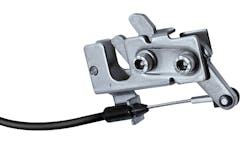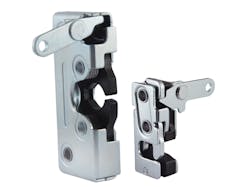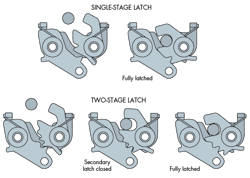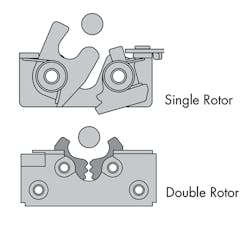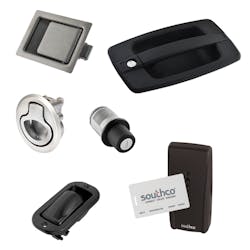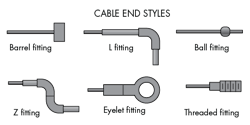In any mechanical system, the best components will only deliver optimum performance if they are designed to work together and are properly connected. Nowhere is this better exemplified than in the area of rotary latches.
Rotary latches provide an effective and reliable means of remotely opening interior and exterior doors, compartments, hoods, and other compartments. They combine security with push-to-close convenience.
Typically, a rotary latching system consists of three main elements: the rotary latch itself, the actuator (the interface with user), and the cable which connects these two components. For example, one of the most common everyday uses for a rotary latch is to remotely open the hood of car. In that application, a mechanical lever (the actuator) is activated from the driver’s seat. It connects via a routed cable to the latch in the hood. By pulling the lever, the rotary latch is triggered, allowing the hood to be opened remotely.
What ultimately governs the effective and reliable operation, maintenance requirements, and end-user satisfaction of the latch is the level of compatibility between these three elements. Any compromise will ultimately result in poor performance of the latch. Therefore, with several options available, the design engineer should choose all latch elements from a proven supplier whenever possible.
The Latch
Choosing the appropriate rotary latch is crucial because it acts as the heart of the system. The primary deciding factor in any application should be based on the size or strength of the latch required. For example, it might take a stronger latch to open doors on a large piece of off-highway equipment, whereas a light-duty, compact latch would be well suited for opening hidden storage compartments on a luxury yacht.
Another consideration when choosing the latch is deciding whether the application is best served by a single or two-stage latch. A two-stage latch is recommended if greater assurance the possibility of “false” latching is required, and prevents the possibility of a door accidentally opening or not completely closing. One of the most common example of this are the latches in car doors. Even if a car door isn’t closed all the way, it still latches and won’t open, but it’s still not completely closed and will rattle and vibrate. It takes an extra push to ensure the latch is completely engaged and the door is securely closed.
There are also a variety of latch options available that offer differing performance attributes. The choice will always to some extent be determined by whether the latch is to be used on a rigid or a flexible panel. Beyond that, some latches systems offer multiple triggering options, letting the rotary latch be easily configured and mounted without having to change the overall design of the application.
Another important feature to consider when choosing a rotary latch is whether a single or double rotor is required. Most rotary latches are single rotor, with only one rotor engaging the striker. Double rotor latches however, tolerate misalignments and offer even greater strength than single rotor versions, allowing them to withstand higher working loads. Additionally, rotary solutions can have a built-in bumper that traps the striker between a rubber bumper and the rotor. This eliminates noise and vibration caused by normal operation
As the only visible part of the mechanism, actuators serve as a “touchpoint” or interface between users and the latching mechanism. Although the actuator’s functionality is undeniably important, the overall “feel” of it can create a powerful impression on users.
Depending on the needs of the application, the actuator also provides enhanced strength and security, as well as good ergonomic design.
Selecting the appropriate actuator generally depends on whether it will be used inside or outside the application. For interior applications, finger pull/paddle actuators or push buttons are most commonly used, as they provide a flush surface. Another popular option is a simple, economical T-handle, which allows for an increased level of ergonomics in triggering the system.
Actuators can be made of a broad variety of materialsm, including plastics and zinc or aluminum die cast. Plastics are the most economical choice, but zinc or aluminum may be preferred due to strength considerations and the perceived quality of a metal product.
For exterior actuation, other specification considerations come into play. These include the desired level of security, the need for a larger design to accommodate gloved hands, and available corrosion-resistant materials. The choice for actuators is also broad, ranging from flush, surface-mount, and push handles to push buttons. Almost all types of actuators can include multiple key code options.
For enhanced security in applications highly prone to theft or vandalism (such as construction equipment left overnight on a job site), designers can choose an electromechanical access device—e.g., a key fob connected to an internal electronic actuator. The key advantage provided by electromechanical devices is their ability to remotely control and monitor user credentials. They can also create a digital record of access; this can be used to demonstrate compliance with industry-accredited associations, similar to what CESAR, a UK-based organization, does for Datatag security markings.
The cable should effectively transfer the mechanical input from the operator via the actuator to the rotary latch, allowing it to open as quickly and safely as possible. Engineers generally face a choice between bare and coated cables, which are commonly used in “line of sight” applications, such as where the actuation point needs to be located in an area separate from the actual rotary latch. For example, on an RV, there may be a need to install several, fairly wide panels down the side of the vehicle for storage. In this case, the actuator would be designed into the center of the panel for ergonomic advantage, while the rotary latches would be located on each edge of the panel to ensure secure closure against the frame.
Cables are usually coated with vinyl, which improves aesthetics and protects the cable itself. The cable should ideally be stainless steel, which combines corrosion resistance with strength and minimal stretch even after thousands of cycles. An acetal liner, which is integrated into the jacketed cable, lets it move and flex inside the jacket without wearing through during high cycle use. This ensures the cable runs smoothly and can turn through a bulkhead or around a curve.
End fitting options offer a high degree of flexibility and enables rotary systems to be easily added into existing designs where there may already be an actuator in place. Many manufacturers offer a range of cable end fittings—barrel, L, Z, eyelet, ball fitting, and bare cable are among the most common.
Barrel fittings are compact and easily attach to any actuator, while ball fittings can be attached to actuators as well as rotary latches. L fittings are designed specifically for rotary latches and must to be used with a retaining clip, which eliminates metal-on-metal contact. Z fittings, on the other hand, can be used without a retaining clip, but they do not offer a high level of vibration resistance. The eyelet fitting is designed to accommodate round hardware such as a cylindrical mounting pin. for applications where the cable will be threaded through a hole and have a set screw to tighten down on, bare cable is often the best option.
James Stroud, Global Product Manager
Southco, Concordville, Pa.
Looking for parts? Go to SourceESB.
